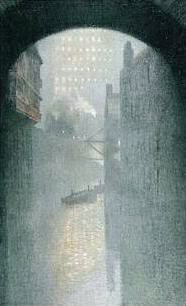Our second student lecture report comes from Sarah Ibberson of Bolton School Girls’ Division.

India House, by Pierre Adolphe Valette. Dr Starkey pointed out that the impressionist mistiness of the painting in fact reflected the Manchester smog.
On Monday 12th of January 2015 Bolton School was pleased to welcome Dr Charlotte Starkey to lecture on the contrasting perspectives of nineteenth century industrial landscapes. Dr Starkey considered the split between the arts and sciences in Victorian engineering, referencing the completion of the phenomenon which was the Barton Aqueduct in 1761, as well as covering the logic behind the expansion of the cotton industry in the North West. She went on to speak about how Manchester was the centre of cotton industry due to the extensive rivers and marshes covering the landscape, an ideal environment for the harvested cotton plant. She then went on to consider the economic and social grounds for the expansion of cotton, including the profits Lancashire merchants sought from the growth of the cotton industry, and the links people already had with the East India Company, thus increasing the demand for finer, more elegant textiles. Robert Rawlinson was discussed for his commitment to resolving the repercussions of the revolution. His visit to the Crimea during the war of the 1850s was a prime example of his success in the practice of basic hygiene as within weeks he had halved the mortality rates at the hospitals simply by improving their conditions.
The rapid advancements of the Industrial Revolution, primarily focussing on the profits of industry, consequently led to the problems of bad sanitation and slums due to a lack of town planning and preparation for the repercussions of the expeditious growth of industry. The lecture further reflected on the work of the engineers who contributed to the Industrial Revolution and the ones who contributed to the correcting of its unintended effects. Dr Starkey used the conflicting interpretations of artists and scientists of the time to portray the differing opinions of the benefits and disadvantageous effects of the revolution.
